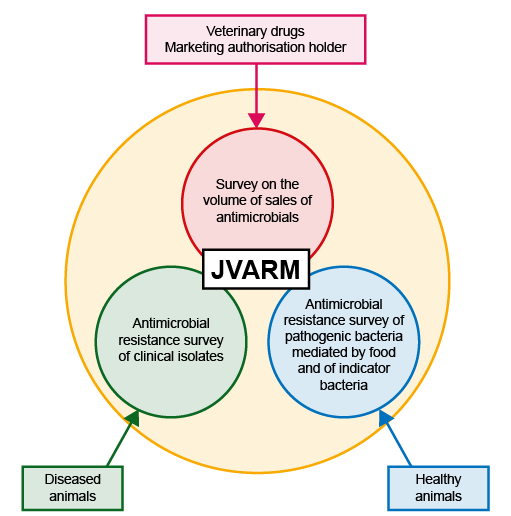4.3 Different types of AMR surveillance
At the time of writing, there are known to be over 70 different AMR national or multi-national surveillance systems operating in 35 countries, spanning human, animal and agricultural sectors. The vast majority of these (90%) operate at single-country level and are known as ‘national AMR surveillance systems’, with the remainder operating across several countries. Let us discuss some examples. Keep an eye out for information on the benefits of these systems, their precise purpose, the type of data they collect, how they link surveillance data to practice (for example, designing of interventions), and whether they operate at a local, national or global level (Diallo, 2020). Bacterial AMR surveillance systems may look at types of bacteria and resistance patterns, and/or they may collect data on antimicrobial consumption and use.
Example 1: The
- Streptococcus pneumoniae
- Haemophilus influenzae
- Salmonella enterica serotype Typhi
- Non-typhoidal Salmonella species
- Staphylococcus aureus
- Escherichia coli
- Klebsiella pneumoniae
The system uses clinical samples which are sent to medical laboratories for confirmation of the presence of disease-causing bacteria. When these bacteria are identified, data are collected on which antibiotics the bacteria are resistant to (
Figure 3 shows the geographic distribution of penicillin antibiotic resistance in one of these bacteria – Streptococcus pneumoniae (which causes infections such as pneumonia (in the lungs), meningitis (in the brain and spinal cord) and bacteraemia (in the blood)) – in the Philippines in 2019. These data show that in several regions of the country, there are moderate (11–25%) or high levels of penicillin resistance (>25%) occurring in this medically important bacteria. This AMR surveillance is, therefore, key to understanding where in the Philippines resistant strains are most commonly found and hence where public health interventions relating to AMR in this bacteria should be targeted.

Example 2:
JVARM aims to collect two types of data:
- Data on AMR among bacteria isolated from healthy food-producing animals and those from diseased animals.
- Data on the sale of antimicrobials in the animal health sector. These type of data allows countries to monitor the volume of antimicrobials used by the country, which is a useful indicator, as high sale of antimicrobials often points to their overuse, something countries are keen to prevent. Overuse likely contributes to increased prevalence of bacterial AMR. This concept of measuring ‘antimicrobial consumption’ (AMC) will be discussed in depth in the module Introducing AMR surveillance systems.
Data on AMR among bacteria are gathered by way of collecting samples from healthy animals as well as from diseased animals on a continuous basis. Animal health settings where these data are collected include farms, veterinary practices and slaughterhouses. Data on the following bacterial species are collected in this system:
- Salmonella species
- Campylobacter jejuni
- Campylobacter coli
- Escherichia coli
- Enterococcus faecium
- Enterococcus faecalis
- Klebsiella pneumoniae
Data on the sale of antimicrobials (in kg of antimicrobials) are collected annually in Japan via the

We hope the above examples give you an introduction to the types of AMR surveillance systems that exist. These systems vary in what their purpose is, the kind of data they collect, their sources of data and how they add to the knowledge base. The common feature of these surveillance systems is that they allow authorities to focus their efforts in mitigating the spread of AMR.
4.2 What is the purpose of AMR surveillance?



